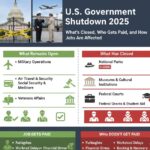
The US federal government officially entered a shutdown at 12:01 AM ET on October 1, 2025, after Congress failed to pass a funding bill. The shutdown has wide-reaching effects on federal operations, employees, contractors, and the public. Here’s a detailed look at what’s closed, what continues, and how jobs are affected.
What Remains Open
Despite the shutdown, essential services continue, focusing on protecting life and property. Key operations that remain functional include:
- Military Operations: Active-duty personnel continue working, though they initially work without pay.
- Air Travel & Security: Air traffic controllers and TSA agents remain on duty to ensure safety.
- Social Security & Medicare: These programs are funded separately, so benefits continue without interruption.
- Postal Service: Mail delivery remains unaffected.
- Veterans Affairs: Hospitals and outpatient clinics continue operations, and benefits are still processed.
What Has Closed
Many non-essential federal operations are halted due to the shutdown. Closures include:
- National Parks: Open-air areas may be accessible, but many parks are closed due to staffing shortages.
- Museums & Cultural Institutions: Smithsonian museums and the National Zoo are closed.
- Federal Courts: Some cases may be delayed or rescheduled.
- Federal Agencies: Departments such as Education, Commerce, and Agriculture have furloughed a large portion of staff.
- Federal Grants & Student Aid: Issuance of new grants is halted, and processing of new federal student aid may be delayed.
The shutdown impacts approximately 750,000 federal workers daily, with an estimated $400 million in lost compensation per day.
Who Gets Paid
- Essential Federal Employees: Military personnel, air traffic controllers, TSA agents, law enforcement, and VA staff continue working. They are initially unpaid but typically receive back pay once the shutdown ends.
- Social Security & Medicare Recipients: Benefits continue as usual.
- Postal Service Employees: USPS operations continue, and employees are paid.
Who Doesn’t Get Paid
- Non-Essential Federal Employees: Those in departments like Education, Commerce, and Agriculture are furloughed and do not receive pay during the shutdown, though back pay is often approved later.
- Federal Contractors: Hourly workers, janitors, IT support, and security contractors may not receive pay and could face financial difficulties. Unlike federal employees, back pay is not guaranteed.
Job Impacts
- Furloughs: Non-essential employees are temporarily laid off.
- Workload Delays: Programs like grants, student aid processing, business licensing, and court hearings are delayed.
- Financial Stress: Essential employees working without pay and contractors face immediate financial strain.
- Backlog & Recovery: Agencies must catch up once funding resumes, potentially slowing services for weeks.
The 2025 government shutdown highlights the crucial distinction between essential and non-essential services, while illustrating the economic ripple effects on millions of federal employees and contractors. While essential services continue, many Americans may experience delays in services ranging from national park visits to new student aid applications.
